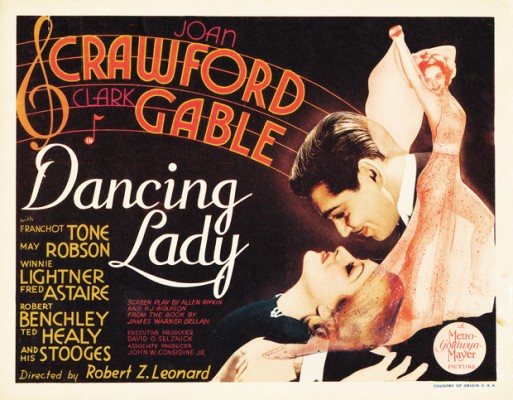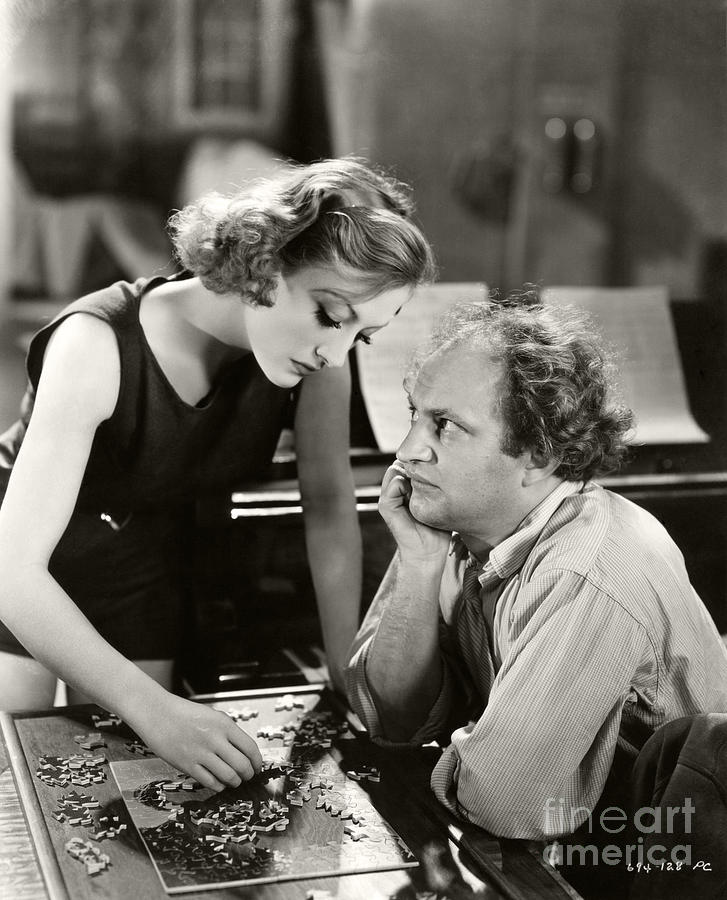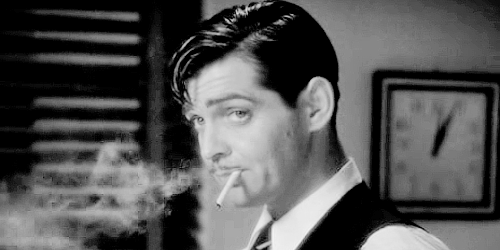Era uma vez Joan Crawford, ou melhor, Janie Bartow.
Assim como Mia de La La Land, ela acha que dança bem e está disposta a fazer de
tudo para se tornar uma estrela da Broadway. É a MGM dos anos 30, então nós
podemos ter certeza de que ela alcançará o sucesso. Porém, aqui o objetivo não
é o mais importante – estamos muito mais interessadas na jornada até atingi-lo.
Once upon a time, there was Joan Crawford, or better,
Janie Bartow. Like Mia from La La Land, she thinks she can dance and is willing
to do anything to become a star on Broadway. It’s 1930’s MGM, so we can be sure
she’ll succeed. But here the finish line is not important – we’re much more
interested in the journey.
Tod Newton (Franchot Tone) é um homem rico cujo
conceito de diversão é bem estranho. Ele paga o ingresso de seus amigos ricos e
também de um mendigo para que todos possam assistir a um strip-tease burlesco
que acaba com a polícia invadindo o teatro e prendendo as dançarinas. Então Tod
vai até a delegacia assistir ao julgamento improvisado. Ele se encanta com
Janie (Crawford) e paga a fiança de 30 dólares, livrando-a da cadeia.
Tod Newton (Franchot Tone) is a rich man whose concept
of fun is a little weird. He pays entrances to his rich friends and also to a
beggar for a Burlesque striptease act that ends up with the dancers being arrested
for indecency. Then Tod follows the girls to the court in order to see the
brief judgment. He is then smitten by Janie (Crawford) and pays the $30 bail to
free her from jail.
Janie conta a Tod que ela quer ser levada a sério
como dançarina. No dia seguinte, ela vai atrás deste sonho e também do Midas do
teatro musical Patch Gallagher (Clark Gable). Ela não consegue nem chegar perto
dele para pedir para fazer um teste, e mais uma vez Tod a ajuda.
Janie tells Tod that she wants to be a serious dancer.
The following day, she chases her dream and goes after musical theater Midas
Patch Gallagher (Clark Gable). She can't even get near him to discuss an
audition, and once again Tod appears to offer help.
Tod envia uma carta de recomendação ao chefe de
Gallagher e Janie é chamada para um teste – mas com os Três Patetas
acompanhando-a ao piano. Ela se mostra mais esperta que eles – o que não é
muito difícil – e prova que sabe sapatear.
Tod sends a recommendation letter to Gallagher's boss
and Janie is given an audition – but with the Three Stooges accompanying her at
the piano. She outsmarts them – which is not really difficult – and proves that
she can tap dance.
Ela consegue o papel, e frequentemente discute com
Gallagher. Ao mesmo tempo, Tod investe no show, e continua paquerando-a. Janie
se diverte com ele, mas confessa que não está interessada em casamento – ela quer
focar em seu objetivo e ajudar o show a ser um sucesso.
She gets the part, and often clashes with tough
Gallagher. At the same time, Tod puts money on the show, and goes on with his
courting. Janie has a good time with him, but tells him she's not interesting
in marriage – she wants to focus on becoming a real dancer and help the show.
Algumas sequências mais rápidas parecem tiradas de
filmes mudos – por exemplo, quando Janie toma o trem para ir até o centro em
busca de seu sonho, ou quando ela está seguindo Gallagher. Há também um pouco
da audácia dos filmes pre-Code, com roupas transparentes, dançarinas mal
cobrindo seus mamilos e um uso específico de sombras enquanto as moças trocam
de roupa.
Some fast sequences look like taken from silent films
– for instance, when Janie first gets the train to go downtown after her dream,
and when she is following Gallagher everywhere in order to be noticed. There is
a little pre-Code naughtiness, too, with transparent gowns, dancers barely
hiding their nipples and a specific use of shadows when the girls change clothes.
Quando o show finalmente estreia, percebemos que é
um espetáculo kitsch. Com o intuito de superar os musicais de Busby Berkeley
feitos na Warner, a MGM adiciona a “Amor de Dançarina” um breve momento em que
acreditamos que vai começar a mágica do caleidoscópio, mas nada isso acontece.
No lugar, temos um tapete voador, Crawford e Astaire com trajes típicos da
Bavária – Joan com tranças loiras e Fred com um fino bigode – e então Nelson
Eddy interrompendo franceses do século XVIII e convidando-os para virem para os
dias atuais – onde, vestidos com celofane, eles dançam e tudo acaba em um
carrossel!
When the show finally opens, we realize that it is a
kitsch extravaganza. In order to top Busby Berkeley's musicals being made then
at Warner, MGM puts in “Dancing Lady” a brief moment in which we believe the kaleidoscopic
magic will appear, but it doesn't. Instead, we have a flying carpet, Crawford
and Astaire dressed as Bavarians – with Joan in blonde braids and Fred with a
thin mustache – and then Nelson Eddy interrupting French people from the 18th
century and inviting them to the modern days – where, dressed in cellophane
dresses, they have a dance-off that ends in a merry-go-round!
Em sétimo nos créditos, atrás de uma atriz chamada
Winnie Lightner, há alguém chamado Fred Astaire. Pior, creditados como
auxiliares, temos Nelson Eddy e Sterling Holloway. Pior ainda, Eve Arden e Lynn
Bari sequer são creditadas!
Seventh billed, behind someone called Winnie Lightner,
there is another someone called Fred Astaire. Worse, billed as supporting
players, we have Nelson Eddy and Sterling Holloway. Even worst, Eve Arden and
Lynn Bari are not even credited!
“Amor de Dançarina” foi a estreia de Fred no
cinema, e ele interpreta a si mesmo. Embora Joan seja convincente como
dançarina, para seu parceiro Fred a dança vem naturalmente – ele é mais
gracioso, leve, como se ele tivesse nascido sabendo dançar. Em seu filme
seguinte, ele novamente interpretaria alguém chamado Fred – mas desta vez, ele
dançou com Ginger Rogers, e o resto é história.
“Dancing Lady” was Astaire's film debut, and he goes
by his real name. Although Joan is believable as a dancer, for her partner Fred
it comes naturally – he's smoother, lighter, like he was born dancing. In his next
movie, he would once again play a character named Fred – but this time, he was
paired with Ginger Rogers, and the rest is history.
Nelson Eddy também estreou no cinema em 1933, mas “Amor
de Dançarina” não foi seu primeiro filme – embora tenha sido o primeiro em que
ele recebeu crédito. O diretor de “Amor de Dançarina”, Robert Z. Leonard,
dirigiria quatro musicais de Eddy com Jeanette MacDonald.
Nelson Eddy also debuted on film in 1933, but “Dancing
Lady” wasn’t his very first movie – it was, however, the first in which he was
credited. Director Robert Z. Leonard directed “Dancing Lady”, and would go on
to direct four Eddy – MacDonald musicals.
Franchot Tone interpreta o playboy rico interessado
na protagonista – o mesmo tipo de papel que ele interpretaria no ano seguinte
em “Boca para Beijar”, desta vez ao lado de Jean Harlow. O próprio Tone era de
uma família rica e havia estudado na Cornell University – neste contexto, ele
era o oposto de Joan Crawford. Joan e Franchot estavam namorando durante as
filmagens de “Amor de Dançarina”, mas negavam o namoro para os jornalistas que
perguntavam – afinal, o divórcio de Joan de Douglas Fairbanks Jr ainda não
havia saído. Há boatos de que a rivalidade entre Bette Davis e Joan começou em
1935 foi causada por Franchot.
Franchot Tone plays the rich playboy interested in the
leading lady – the same kind of role he’d play the following year in “The Girl
from Missouri”, this time with Jean Harlow. Tone himself was from a wealthy
family and attended Cornell University – in this sense, he was the opposite of
Joan Crawford. Joan and Franchot were dating when “Dancing Lady” was being
filmed, but they denied the romance to the magazine columnists who asked about
it – after all, Joan’s divorce to Douglas Fairbanks Jr wasn’t yet completed.
Rumor has it that Franchot was the reason behind Bette Davis’s and Joan’s feud,
which started in 1935.
“Amor de Dançarina” foi um grande sucesso, mas não
é nenhuma obra-prima. Nele falta a redenção e o toque sério que existem nos
números finais dos musicais da Warner Brothers. É um filme de muitas estreias
no elenco coadjuvante, mas ele pertence a Joan Crawford, e é seu carisma que
nos faz acreditar que qualquer um pode triunfar na Broadway.
“Dancing Lady” was a huge success, but it’s far from a
masterpiece. It lacks the redemption and serious touches that Warner Brothers
musicals added to their finales. It’s a film of many debuts in the supporting
cast, but it belongs to Joan Crawford, and her charisma that makes us believe
anyone can triumph on Broadway.
This is my contribution to the Franchot Tone blogathon, hosted by Emily at Finding Franchot.










7 comments:
I must make a confession...I've never even heard of Franchot. Definitely need to broaden my movie horizons a bit!
Have a lovely weekend,
Catherine
Thank you so much for your insightful coverage of Dancing Lady! It's amazing to me just how famous names are in that cast and how many don't get the credit they deserve. I completely agree about some fast-paced footage (the Gable-Crawford chase down the street) looking more like late 1920's film work than 30's. The hair, makeup, and fashion of Joan as Janie is probably my very favorite Joan Crawford style.
I'm so happy you participated in the blogathon!
Lovely post!! I have not yet seen this movie, but it is a must watch for sure. I am so used to seeing Joan Crawford in dramatic roles, but she definitely got her start in the silent and musical realm. And Fred Astaire! I did not know that this was his first film! Thankfully, Flying Down to Rio came out the same year. And the Fred and Ginger magic was born :D !!!
Joan Crawford does indeed make you believe anyone can succeed on Broadway. I also loved the gif you posted where Joan says, "I keep on trying." That feels very, very true to Joan herself.
This sounds like a sensational movie! And that gif of Clark Gable -- zowie!
Look at Larry!! I thought I saw this film but seeing the Three Stooges AND Franchot Tone in it makes me realize that I never did. Heck, I didn't even know Franchot Tone was making films in '33! Now I'll have to see it. Thanks for taking part in the MGM Blogathon, Le!
Post a Comment